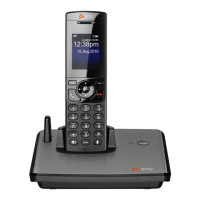Before You Begin
6
The canonical fashion simplifies locating parameters on the phone’s native web portal or on OBiTALK.com.
Canonical Fashion
This example shows the format of the canonical fashion.
● Parameter Group Name::ParameterName = Parameter Value
{replace-with-actual-value}
The Parameter Group Name is the heading of the parameter group on the left side panel of the device local
configuration or OBiTALK Configuration web page. This string may contain spaces. When a group heading
has more than one level, each level is separated with a –, such as:
● Services Providers - ITSP Profile A – SIP:
The ParameterName is the name of the parameter as shown on the web page and MUST NOT CONTAIN
ANY SPACES. Parameter Group Name and ParameterName are separated by two colons (::), as shown
in the first example above.
The Parameter Value is the literal value to assign to the named parameter and may contain spaces. You
can omit Parameter Group Name or its top-level headings when the context is clear. For example:
● SP1 Service::AuthUserName = 4082224312
● ITSP Profile A - SIP::ProxyServer = sip.myserviceprovider.com
● ProxyServerPort = 5082
Literal Fashion
These examples show the format of the literal fashion. The literal fashion is used when provisioning.
● ParameterGroupName.ParameterName.Parameter Value
{replace-with-actual-value}
● Parameter.Group.Name.ParameterGroupName.ParameterName.Parameter Value
The ParameterGroupName. is the name of the first parameter group in literal fashion. This string MUST
NOT CONTAIN ANY SPACES, and always is terminated with a period, as shown. More than one
ParameterGroupName. may be used. The ParameterGroupName. is case-sensitive.
The ParameterName. is the name of the parameter, and always is terminated with a period, as shown. This
string MUST NOT CONTAIN ANY SPACES. The ParameterName. is case-sensitive.
The Parameter Value is the literal value to assign to the named parameter and may contain spaces. The
Parameter Value is not case-sensitive, but it MUST EXACTLY MATCH the value when one or more
choices are available.
When using the literal fashion in your XML, you need to exactly match the text string for
ParameterGroupName.ParameterName.Parameter Value, but text formatting such as bold face is not
required and is removed when your script or app is processed.
Boolean Values
You can identify parameters that take a Boolean value on your phone’s configuration web pages by a check
box next to the parameter name. Throughout the document, we refer to a Boolean value as “enable or
disable” or “yes or no”, but the only valid Boolean parameter values to use in a phone configuration file is

